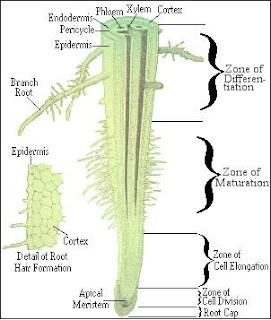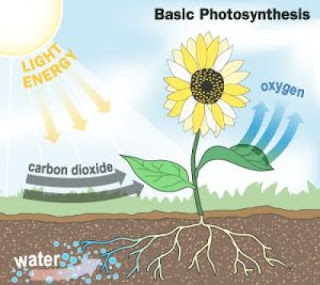Peristiwa utama pada awalnya pembentukan akar adalah pembentukan meristem akesnya. Saat biji berkecambah, promeristem di ujung akar embrio membentuk akar utama. Penelitian fisiologi biokimia menunjukan bahwa pada umumnya pemula yang menyebabkan pola dsar akar berhenti membelah pada saat pertumbuhan akar berlangsung. Aktivitas pertumbuhan digantikan oleh sel yang terletak lebih dalam (Hidayat, 1995)
Dalam embrio biji mengandung sebuah radikula atau meristem akar untuk pengembangan akar utama. Akar pertama ini bercabang dan memanjang menghasilkan sistem perakaran serabut atau kembal mati. Sementara pucuk literal muncul pada akar, batang akar literal muncul dari lapisan terluar dari partikel. Selama inisiasi akar literal, sel-sel perisikel menjadi meristematis membentuk primordial akar yang tumbuh melewati endodermis, korteks dan epidermis. Sebelum akar literal merobek jaringan permukaan akar utama, akar tersebut membentuk meristem apical dan tudung akar. Pada beberapa jarak tertentu dari promeristem, sel membesar dan berkembang menjadi sel terspesialisasi. Hal itu melibatkan masa pemanjangan sebagian besar sel yang terjadi dibelakang pelebaran awal dari ujung akar. Batas epidermis, korteks dan silinder pusat tampak dekat belakang promeristem. Korteks bertambah lebar karena pembelahan periklinal serta pembesaran dari pada sel ke arah radial. Sel metaxilem membesar dan menghasilkan vakuola yang besar (Hidayat, 1995)
Pada gimnospermae dan angiospermae, akar literal biasanya dimulai dalam perisikel dan dari sini ke korteks akar induk sampai ke sisi luar, (Ogura 1938). Pada angiospermae, perimordium akar literal terbentuk dari belahan periklinal dan antiklinal sebuah gugus sel perisikel (Fahn, 1995)
Bell dan Mc Cully (1970) dalam fahm (1995) mengamati bahwa pada Zea may tahap awal irisan akar literal yang berdekatan dengan kutub protoxilem, tidak saja melibatkan sel-sel persikel tetapi juga banyak sekali sel-sel parenkim dari bagian terdekat stele. Sebagai pertumbuhan lanjut, promiridias tersebut menembus korteks akar induknya. Endodermis dapat membelah secara antiklinal dan periklinal, membentuk lebih dari satu sel. Dengan menyembulkan akar literal ke permukaan akar induk, atau bahkan sebelum itu terjadi, jaringan yang berkembang dari endodermis itu mati dan akhirnya digugurkan (Fahn, 1995)
Menurut Hidayat (1995) pembentuk akar literal dimulai dengan pembelahan periklinal yang terjadi pada beberapa sel perisikel, sel yang dihasilkan membelah lagi secara pereklinal atau antiklinal sehingga terjadi suatu himpunan sel. Pada waktu primordial akar bertambah panjang, korteks ditembus sehingga akar literal muncul dipermukaan akar induk. Diawali perkembangan sel endodermis di luarnya membelah secara antiklinal untuk mengikuti pembesaran akar baru itu dan rusak.
PENYEBARAN AKAR
Laju penyebaran akar, seperti halnya karakteristik sistem perakaran di pengaruhi oleh faktor genetik dan lingkungan. Di bawah kondisi konstan laju pertumbuhan akar yang berkembang tergantung pada diameternya. Meristem yang lebar menunjukan pertumbuhan yang cepat (Russel, 1977). Bentuk dan laju pertumbuhan akar dipengaruhi secara nyata oleh media perakaran (kozlowzki, 1971), distribusi perakaran merupakan fungsi dari spesies, umur pohon, lingkungan dan unit ukuran. Perakaran yang halus biasanya mewakili 85-99% total panjang akar, tetapi hanya 14-16% total berat akar (Lyr dan Hoffman dalam F.S daniel T.W and Helms J.A, 1987)
Jumlah kapasitas akar menunjukan kapasitas absorbsi dari akar, total jumlah akar biasanya dinyatakan dalam gram akar kering tetapi juga bisa dinyatakan dalam total panjang akar atau total permukaan akar. Total permukaan akar merupakan karakteristik penting tetapi sulit untuk dihitung. Total berat akar dapat dinyatakan dalam satuan perhektar sebagai parameter dari suplai bahan organik ke tanah (Schuurman and Goedewaagen, 1971) Sedangkan menurut Bohn 1979, parameter yang umum digunakan untuk menyatakan pertumbuhan dan penyebaran akar adalah jumlah, berat, luas permukaan, volume, diameter, panjang dan jumlah ujung akar.
Perkembangan akar dipengaruhi oleh suhu, oksige, kesuburan tanah rintangan mekanis. Suhu rendah menghambat pertumbuhan, metabolisme dan pendewasaan akar. Pada suhu rendah air menjadi pekat dan jaringan menjadi kurang permeabel. Pada suhu tinggi kecepatan respirasi mengurangi pertumbuhan akar (Baker et al, 1987). Sedangkan menurut Kozlowzki (1971) Bahwa karakteristik pertumbuhan akar pohon sebagian besar dipengaruhi oleh persaingan spesies, media perakaran dan teknik budidaya.
Akar tanaman sering menyebar secara lateral sejauh lebar tajuk, namun penyebaran akar akan sangat bervariasi sesuai dengan keadaan tempat tumbuh dan tipe tanah.
Kozlozki (1971) menemukan bahwa akar pohon berbuah yang tumbuh pada lempung menyebar secara lateral kira-kira dua kali panjang tajuk, pada tanah liat satu setengah kali dan pada pasir tiga kali. Sedangkan menurut Baker (1987) penyebaran lateral sistem perakaran biasanya 2 sampai 5 kali radius tajuk, menjadi lebih besar pada tempat tumbuh yang jelek pada kondisi kering.
Scholter (1948) menunjukan perbedaan dalam perkembangan akar. Semai pinus 4 bulan tumbuh tanpa saingan memiliki jumlah akar 419 dengan panjang total 5,3 feet. Sementara Robinia pseudoaacacia lebih 1000 dengan panjang total 1069 feet.
PENGARUH KONDISI TANAH TERHADAP PERKEMBANGAN AKAR
Tanah merupakan faktor penting dalam pertumbuhan tanaman yaitu sebagai sumber dalam penyediaan unsur hara yang diperlukan untuk pertumbuhan tanaman, tempat akar berpegang serta tumbuh dan tempat penyimpanan air tanah yang sangat vital sebagai kelangsungan hidup tanaman bersangkutan perkembangan akar sangat dipengaruhi oleh keadaan tempat tumbuhnya. Menurut Bohm (1979) faktor ekologis yang penting, yang mempengaruhi pertumbuhan akar adalah Bulkdensity, kekerasan, air, udara dan unsur hara didalam tanah. Menurut Buckman dan Brandy (1969) bahwa faktor yang mempengaruhi pertumbuhan tanaman pada umumnya adalah : 1. cahaya, 2. Bantuan mekanik, 3. Panas, 4. Udara, 5. Air dan 6. Unsur hara. Kecuali cahaya tanah merupakan perantara dalam pemberian semua faktor itu, baik sebagaian atau seluruhnya.
ROOT FORMATION MECHANISM
The main event was initially the formation of root meristem formation akesnya. When the seeds germinate, promeristem in embryo root tips form the main roots. Biochemistry physiology research shows that most beginners that causes the pattern of the bed the roots stop dividing at the time of root growth takes place. Activity growth was replaced by cells located deeper (Hidayat, 1995)
The seeds contain an embryo radicle or root meristem to the primary root development. This first root branching and root system extends to produce fibers or back dead. While literally shoots appear on the roots, stems roots literally emerged from the outermost layer of the particle. Over the literal root initiation, the cells forming primordial perisikel be meristematis roots that grow through the endodermis, cortex and epidermis. Prior to literally rip the roots of the primary root surface tissues, the root apical meristem and cap forming roots. At some distance from promeristem, cells enlarge and develop into specialized cells. It involves the elongation of most of the cells that occurs behind the initial widening of the root tips. Limit the epidermis, cortex and central cylinder appears near the rear promeristem. Increased cortical width because periklinal division and enlargement of the cells to the radial direction. Tues metaxilem enlarge and produce large vacuoles (Hidayat, 1995)
In gimnospermae and angiospermae, literal roots usually begins in perisikel and from here into the parent root cortex to the outer side, (Ogura 1938). In angiospermae, perimordium literal roots formed from parts of periklinal and antiklinal a cell cluster perisikel (Fahn, 1995)
Bell and Mc Cully (1970) in fahm (1995) observed that in the early stages of Zea May literal root slices adjacent to the pole protoxilem, not only involve persikel cells but also lots of parenchymal cells from the nearest part of Stele. As growth continued, it penetrates promiridias parent root cortex. Endodermis can divide antiklinal and periklinal, forming more than one cell. With roots menyembulkan literally to the root surface of the parent, or even before that happens, the tissue that develops from the endodermis was dead and eventually aborted (Fahn, 1995)
According to Hidayat (1995) forming the roots of the literal begins with periklinal division that occurs in some perisikel cells, the cell divides again resulting in pereklinal or antiklinal resulting in a set of cells. At the time of primordial roots grew longer, so that the roots penetrate the cortex literally appears on the surface of the parent root. Preceded the development of endodermis cells in the outer divide antiklinal to follow the new root enlargement and damaged.
ROOT DISTRIBUTION
The rate of spread of the roots, as well as the characteristics of the root system is influenced by genetic and environmental factors. Under conditions of constant rate of root growth that develops depends on its diameter. Wide meristem showed rapid growth (Russell, 1977). The form and rate of root growth is influenced significantly by the rooting medium (kozlowzki, 1971), the distribution of roots is a function of species, tree age, environment and unit sizes. Fine roots typically represent 85-99% of total root length, but only 14-16% of total root weight (full scr and Hoffman in FS daniel TW and JA Helms, 1987)
Total capacity of the roots showed absorption capacity of roots, the total number of roots is usually expressed in grams of dried roots but can also be expressed in total root length or total root surface. Total root surface is an important characteristic, but difficult to calculate. Total weight of roots can be expressed in units per hectare as a parameter of the supply of organic material to soil (Schuurman and Goedewaagen, 1971) Meanwhile, according to Bohn, 1979, the parameters commonly used to express the growth and spread of roots is the number, weight, surface area, volume, diameter, length and number of root tips.
Root development is influenced by temperature, oksige, soil fertility, mechanical barrier. Low temperature inhibits the growth, metabolism and maturation of roots. At low temperatures water becomes dense and the network becomes less permeable. At high temperature reduces the respiration rate of root growth (Baker et al, 1987). Meanwhile, according Kozlowzki (1971) The characteristics of tree root growth largely influenced by the competition of species, rooting medium and cultivation techniques. Plant roots often spread laterally as far as width header, but the spread of the roots will vary according to the state of the site and soil type.
Kozlozki (1971) found that the roots of fruit trees growing on clay spread laterally approximately twice the length of the header, on clay and a half times and three times on the sand. Meanwhile, according to Baker (1987) Lateral spread of root system usually 2 to 5 times the canopy radius, becomes larger in a bad place to grow in dry conditions.
Scholter (1948) showed differences in root development. 4 months pine seedlings grown without root competition has a number of 419 with a total length of 5.3 feet. While Robinia pseudoaacacia over 1000 with total length of 1069 feet.
Scholter (1948) showed differences in root development. 4 months pine seedlings grown without root competition has a number of 419 with a total length of 5.3 feet. While Robinia pseudoaacacia over 1000 with total length of 1069 feet.
EFFECT OF SOIL CONDITIONS ON ROOT GROWTH
Soil is an important factor in plant growth that is as a source in the supply of nutrients necessary for plant growth, a place to hold and grow roots and soil water storage is very vital as the survival of the relevant plant root development is influenced by the circumstances where it grew. According to Bohm (1979) are important ecological factors, which affect root growth is Bulkdensity, violence, water, air and nutrients in the soil. According to Buckman and Brandy (1969) that the factors that affect plant growth in general is: 1. light, 2. Mechanical assistance, 3. Heat, 4. Air, 5. Water and 6. Nutrients. Except for light soils is an intermediary in the provision of all these factors, either in part or entirely.



Comments
Post a Comment
Isi Komentar kamu untuk Posting ini!!